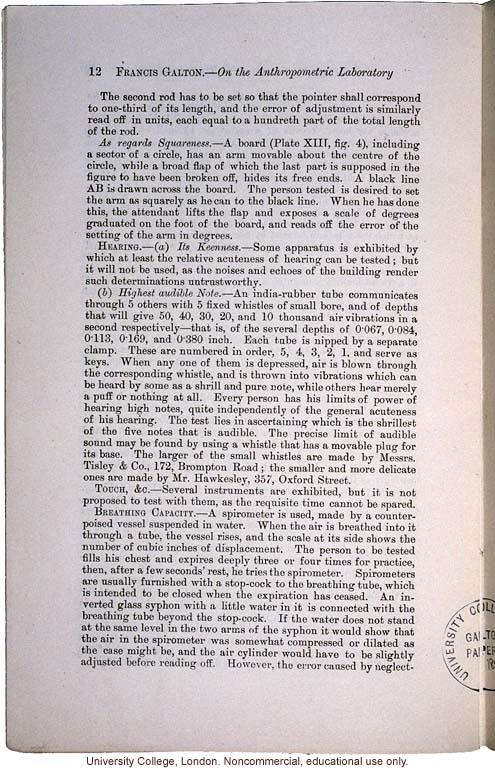12 Francis Galton. - On the Anthropometric Laboratory
The second rod has to be set so that the pointer shall correspond to one-third of its length, and the error of adjustment is similarly read off in units, each equal to a hundredth part of the total length of the rod.
[italics]As regards Squareness. -[end italics] A board (Plate XIII, fig. 4), including a sector of a circle, has an arm movable about the centre of the circle, while a broad flap of which the last part is supposed in the figure to have broken off, hides its free ends. A black line AB is drawn across the board. The person tested is desired to set the arm as squarely as he can to the black line. When he has done this, the attendant lifts the flap and exposes a scale of degrees graduated on the foot of the board, and reads off the error of the setting of the arm in degrees.
Hearing. - ([italics]a[end italics]) [italics]Its Keenness[end italics]. - Some apparatus is exhibited by which at least the relative acuteness of hearing can be tested; but it will not be used, as the noises and echoes of the building render such determinations untrustworthy.
([italics]b[end italics]) [italics]Highest audible Note[end italics]. - An india-rubber tube communicates through 5 others with 5 fixed whistles of small bore, and of depths that will give 50, 40, 30, 20, and 10 thousand air vibrations in a second respectively - that is, of the several depths of 0.067, 0.084, 0.113, 0.169, and 0.380 inch. Each tube is nipped by a separate clamp. These are numbered in order, 5, 4, 3, 2, 1, and serve as keys. When any one of them is depressed, air is blown through the corresponding whistle, and is thrown into vibrations which can be heard by some as a shrill and pure note, while other hear merely a puff or nothing at all. Every person has his limits of power of hearing high notes, quite independently of the general acuteness of his hearing. The test lies in ascertaining which is the shrillest of the five notes that is audible. The precise limit of audible sound may be found by using a whistle that has a movable plug for its base. The larger of the small whistles are made by Messrs. Tisley & Co., 172, Brompton Road; the smaller and more delicate ones are made by Mr. Hawkesley, 357, Oxford Street.
Touch, &c. Several instruments are exhibited, but it is not proposed to test with them, as the requisite time cannot be spared.
Breathing Capacity. - A spirometer is used, made by a counterpoised vessel suspended in water. When the air is breathed into it througha tube, the vessel rises, and the scale at its side show the number of cubic inches of displacement. The person to be tested fills his chest and expires deeply three or four times for practice, then, after a few seconds' rest, he tries the spirometer. Spirometers are usually furnished with a stop-cock to the breathing tube, which is intended to be closed when the expiration has ceased. An inverted glass siphon with a little water in it is connected with the breathing tube beyond the stop-cock. If the water does not stand at the same level in the two arms of the siphon it would show that the air in the spirometer was somewhat compressed or dilated as the case might be, and the air cylinder would have to be slightly adjusted before reading off. However, the error caused by neglect-
[end]


